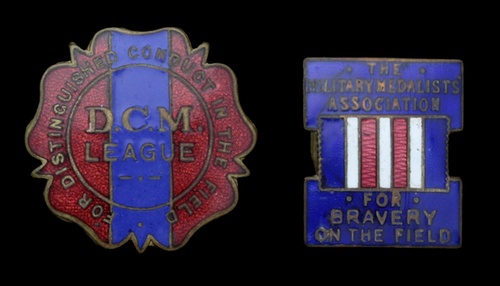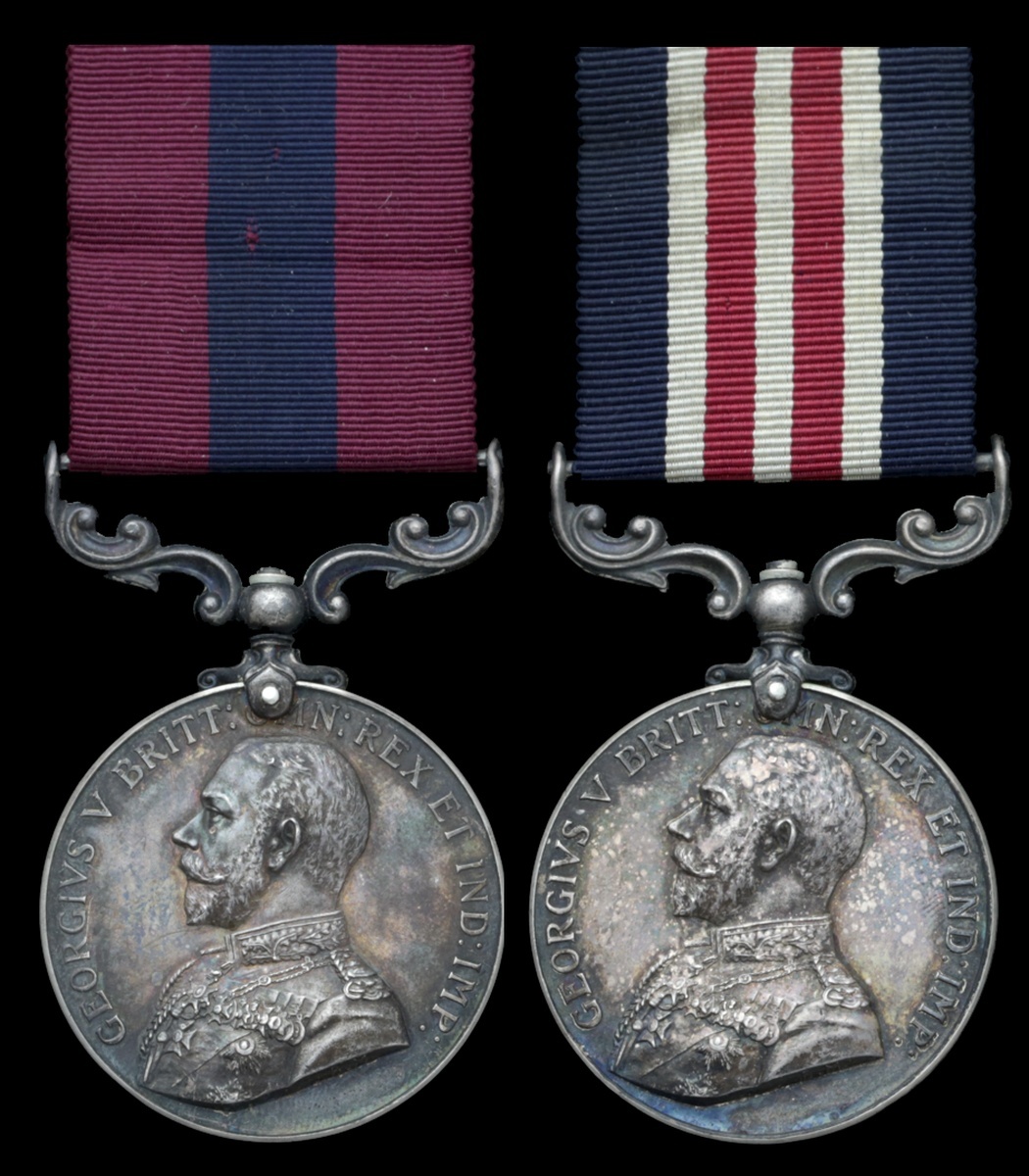Auction: 22075 - Orders, Decorations and Medals
Lot: 113
A Great War Palestine D.C.M., Western Front M.M. pair awarded to Sergeant T. Hyde, 6th Battalion Royal Munster Fusiliers, late 3rd Battalion Welsh Regiment, a Boer War veteran who saw action at Gallipoli, Salonica, Palestine and France
The cool and consistant gallantry he displayed won him plaudits until his long career was tragically ended during the Hundred Days offensive less than a month before the end of the war
Distinguished Conduct Medal, G.V.R. (6-986 A.Sjt: T. Hyde. R. Muns:Fus:); Military Medal, G.V.R. (986 Sjt. T. Hyde. 2/R. Muns:Fus:), minor contact wear, overall very fine (2)
Provenance:
Chris Murphy Collection, DNW, March 2000.
The Royal Munster Fusiliers received a total of 63 D.C.M.’s during the Great War.
D.C.M. London Gazette 1 May 1918:
‘For conspicuous gallantry and devotion to duty. He was in command of a patrol of one platoon which was fired on by the enemy at short range. He at once led his men to the attack and captured an officer and eleven other prisoners, engaged the enemy, inflicting heavy casualties on them, and then withdrew his party, bringing back two of his men who had been wounded. He set a magnificent example of courage and initiative.’
M.M. London Gazette 5 December 1918.
Thomas Hyde was born at St. Mary’s, Cardiff in 1879, the son of Nicholas and Margret Hyde of 14 North William Street, Newtown, Cardiff. Enlisting with the Militia on 3 May 1898, he was posted to the 3rd Battalion Welsh Regiment and embodied for service during the Boer War on 10 January 1900. Serving in Cape Colony for the duration, Hyde was demobilised on 8 March 1902.
Embodied again upon the outbreak of the Great War Hyde joined the 6th Battalion, Royal Munster Fusiliers. The battalion went into action during the Suvla Bay landings on 7 August although Hyde’s M.I.C. doesn’t have him entering that theatre until 9 August when they were stationed on Hill 53. As a result he will have seen heavy fighting at Kiretch Tepe Ridge on 15-16 August which saw 10 officers and 210 other ranks killed, wounded or missing. Having suffered heavy losses and with ill-health reducing their numbers still further, the 6th Battalion was transferred to Salonica, leaving the front on 30 September.
Joining the Salonica front on 5 October 1915 they were swiftly moved north to join the efforts to relieve the Serbian Army as it retreated from the combined Austro-Hungarian, German and Bulgarian assualts. Stationed with 30th Brigade they were in action at the Battle of Kosturino between 6-12 December during the withdrawal from Serbia. Here the 6th Battalion was heavily engaged outside Dedeli but despite holding their positions for some time under a heavy attack- launched under the cover of fog and often repulsed in savage hand-to-hand fighting- they were eventually forced to withdraw.
Having absorbed the remains of the 7th Battalion, Royal Munster Fusiliers they were posted to Egypt on 11 September 1917. From there they took part in the Palestinian Campaign, seeing heavy fighting most notably around a position called ‘machine gun hill’. On approaching this feature Lieutenant Colonel Grange- commanding the 6th Battalion- realised that it would need to be reduced by a frontal assualt. He ordered two platoons from ‘C’ Company- including Hyde's- to advance and reconnoitre this position, led by Captain Keevil and Lieutenant O’Keefe.
Chindwin to Criccieth by Charles Grange provides the details of what happened next stating:
‘We managed to keep down the Turkish fire directly in front of us while Keevil was crossing the open and then they vanished among the rocks and hillocks. Almost at once there was a volley of shots. I could distinguish two Lewis-guns firing hard and here some shouts. “Poor devils,” I thought, “that’s the end of that. I’ve lost a lot of good men when I’ll be needing them.”
Then back trailed an amazing procession, at least it amazed me because the first four figures wore fur coats and because Keevil’s command seemed to have nearly doubled its strength. They reached our line safely and told their tale. Just as we lost sight of them, they’d bumped up against a strong-point well out in front of the main Turkish position and promptly rushed it. Accounts of hand to hand fighting are bound to be a bit confused, but Sergeants Hyde and Thomas had done extra good work, while Private O’ Connor had charged the nearest machine-gun and bayonetted the two Turks behind it. They’d come back with 4 Turkish officers and 19 other ranks, Private O’Conner’s machine-gun and both our own casualties, one wounded and one dead.’
Hyde received the D.C.M. not long later for his part in the capture of Machine-Gun hill and, receiving his award from Brigadier Greer not long later. Grange notes an interesting comment by Hyde during this presentation which highlights the air of steady professionalism that follows his career:
'However, Sergeant Hyde received an immediate award of the D.C. M. and was given it, a few days later, by Brigadier Greer who had relieved fear old Nicol some while back. Hyde apologised to him for not having killed more Turks and explained the reason-
“Sorr, these young soldiers get that excited that they forget their three rules of aiming”’
The 6th Battalion was transferred to the Western Front in June 1918, when Indian Troops began to replace European soldiers in Palestine. Here they were disbanded with a great many men of the 6th Battalion being sent to the 2nd Battalion in order to replenish their numbers, this including Hyde. Taking part in the Hundred Days, the last great offensive of the war, Hyde was wounded in action during these operations- likely during the closing days of the Battle of Selle. He died of his wounds on 27 October 1918 and was buried at the St. Sever cemetery Extension, Rouen. He left behind a widow, Bridget Hyde and was a noted rugby player, belonging to Canton R.F.C. as well as a baseball player; sold together with an original silver cigarette case engraved ‘Sgt. T. Hyde D.C.M. R.M.F.’, a D.C.M. League Badge and Military Medalists Association Badge along with copied research including census data, London Gazette extracts and service papers as well as extracts from the South Wales Daily News, Chindwin to Criccieth and The 2nd Munsters in France along with medal rolls and battalion war diary entries.
Further entitled to the Queen’s South Africa Medal with Cape Colony clasp and King’s South Africa Medal with two clasps as well as the 1914-15 Star and the British War and Victory Medals.
Subject to 20% VAT on Buyer’s Premium. For more information please view Terms and Conditions for Buyers.
Sold for
£3,500







